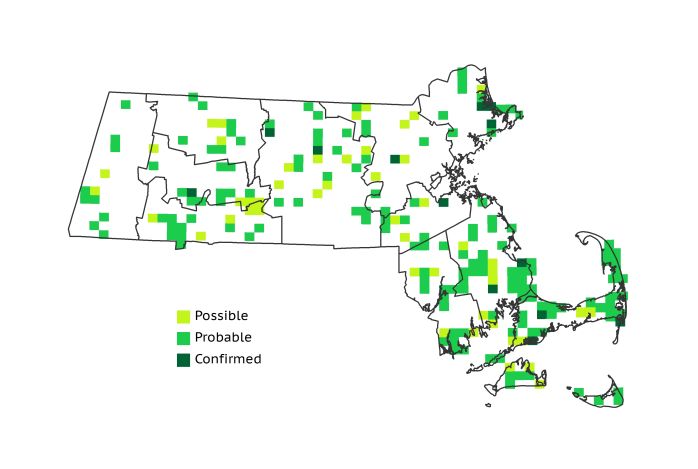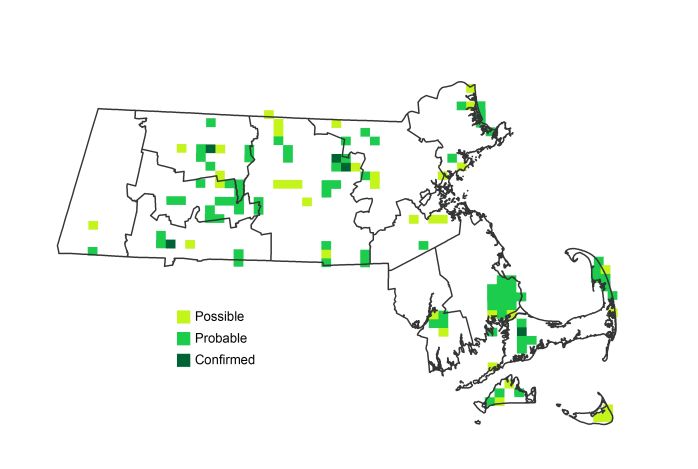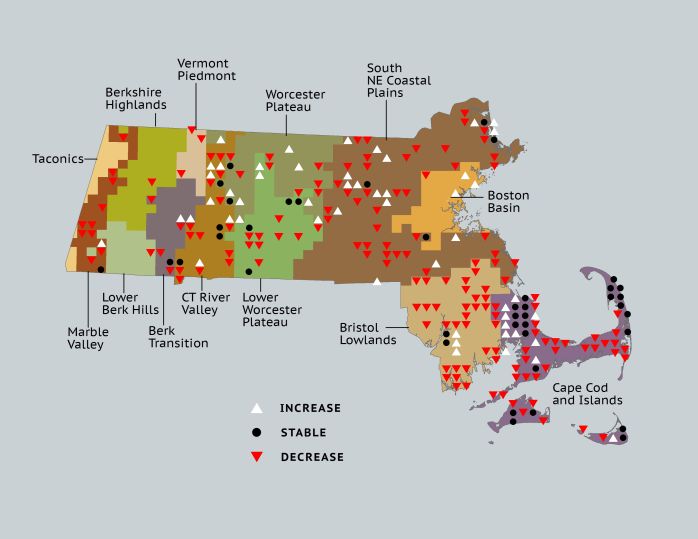Find a Bird
Whip-poor-will
Caprimulgus vociferus

Local and strongly declining
Conservation action urgent
State Wildlife Action Plan listed
“Hear that lonesome whippoorwill, / He sounds too blue to fly. / The midnight train is whining low / I’m so lonesome I could cry.” – Hank Williams, “I’m So Lonesome I Could Cry”
Old New England folk wisdom states that the mysterious Eastern Whip-poor-will captures human souls after they depart their earthly bodies. In reality, whip-poor-wills capture mostly insects, and their mournful calls serve only to proclaim territory and attract mates. Trusting to their excellent camouflage, Eastern Whip-poor-wills typically roost in the woods by day, only to emerge at night to hunt for flying bugs over scrubby forest openings. Loss of these open early-successional areas has likely been a contributing factor to the decline of Eastern Whip-poor-wills in Massachusetts.
Historic Status
The nocturnal nature of whip-poor-wills has long kept them a mystery. Forbush recounted a carriage ride from Barre to Gardner through the darkness during which the birds started to call, spooking his driver into commenting on the “fact” that whip-poor-wills bring bad luck (Forbush 1927). Deforestation for the purpose of creating agricultural land likely caused a population decline in Massachusetts, but even though farming has since declined as a way of life for most Bay State residents, urbanization is on the rise, meaning that suitable habitat for whip-poor-wills is still at a premium in most of the Commonwealth.
Atlas 1 Distribution
Simultaneously loquacious and secretive, the Eastern Whip-poor-will was heard in many places but Confirmed in very few during Atlas 1. The Taconic Mountains failed to report any whips, but there were scattered encounters in the Marble Valleys. The high slopes of the Berkshires hosted very few whip-poor-wills, while more occupied blocks appeared in the Berkshire Transition zone. The Connecticut River Valley had a generous scattering of whip-poor-wills. From the Worcester Plateau east through the Coastal Plains, breeding whip-poor-wills were sparse but fairly evenly distributed in areas of suitable habitat. The Bristol/Narragansett Lowlands had quite a few occupied blocks, but Cape Cod and the Islands took the proverbial cake. Well over a quarter of all Atlas 1 Eastern Whip-poor-will blocks were in the Cape and Islands ecoregion.
Atlas 2 Distribution and Change
But what a difference 30 years can make in the life of a species. The footprint of Eastern Whip-poor-wills was almost halved between the two Atlases, with the species breeding in more than 20% of the state in the 1970s but in only 12% by the time of Atlas 2. While the greatest declines were in the Cape Cod and Islands, Bristol/Narragansett Lowlands, and Coastal Plains ecoregions, nearly all ecoregions suffered general declines in sightings of this species. Concern over this decline resulted in the species being listed as a Species of Special Concern in Massachusetts in 2011. Efforts are currently underway to create more suitable habitat for the species in Massachusetts.
Atlas 1 Map

Atlas 2 Map

Atlas Change Map

Ecoregion Data
Atlas 1 | Atlas 2 | Change | ||||||
Ecoregion | # Blocks | % Blocks | % of Range | # Blocks | % Blocks | % of Range | Change in # Blocks | Change in % Blocks |
Taconic Mountains | 0 | 0.0 | 0.0 | 0 | 0.0 | 0.0 | 0 | 0.0 |
Marble Valleys/Housatonic Valley | 11 | 28.2 | 5.1 | 2 | 5.1 | 1.7 | -9 | -23.1 |
Berkshire Highlands | 1 | 1.8 | 0.5 | 0 | 0.0 | 0.0 | -1 | -1.9 |
Lower Berkshire Hills | 1 | 3.6 | 0.5 | 0 | 0.0 | 0.0 | -1 | -3.7 |
Vermont Piedmont | 3 | 17.6 | 1.4 | 1 | 5.9 | 0.8 | -3 | -25.0 |
Berkshire Transition | 6 | 15.8 | 2.8 | 4 | 10.0 | 3.3 | -2 | -6.5 |
Connecticut River Valley | 18 | 32.1 | 8.4 | 9 | 13.8 | 7.4 | -8 | -16.7 |
Worcester Plateau | 12 | 15.4 | 5.6 | 17 | 19.3 | 14.0 | 2 | 4.2 |
Lower Worcester Plateau | 16 | 21.6 | 7.4 | 11 | 13.8 | 9.1 | -9 | -16.7 |
S. New England Coastal Plains and Hills | 51 | 18.9 | 23.7 | 31 | 11.0 | 25.6 | -24 | -10.6 |
Boston Basin | 1 | 1.8 | 0.5 | 3 | 5.4 | 2.5 | 2 | 3.6 |
Bristol and Narragansett Lowlands | 36 | 34.0 | 16.7 | 6 | 5.3 | 5.0 | -28 | -27.7 |
Cape Cod and Islands | 59 | 43.4 | 27.4 | 37 | 25.7 | 30.6 | -25 | -20.8 |
Statewide Total | 215 | 22.2 | 100.0 | 121 | 11.7 | 100.0 | -106 | -12.8 |
Notes
The Eastern Whip-poor-will shows significant decreasing Breeding Bird Survey trends in Massachusetts, the mid-Atlantic/New England region, and the whole Eastern US.



